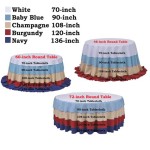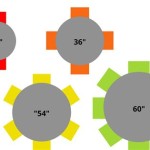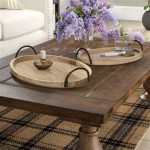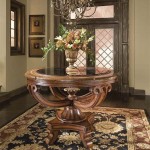What Kind of Rug for a Round Dining Table
Selecting the appropriate rug for underneath a round dining table significantly impacts the aesthetic appeal and functionality of a dining space. The right rug can anchor the table, define the dining area, add warmth and texture, and even protect the flooring. However, choosing the wrong rug can make the space feel disjointed, cramped, or visually unappealing. Several factors should be considered when making this selection, including size, shape, material, style, and pile height. Understanding these considerations will help ensure the chosen rug complements the dining table and the overall design scheme of the room.
Determining the Optimal Rug Size and Shape
The dimensions of the rug are paramount when pairing it with a round dining table. A rug that is too small will appear disproportionate and fail to adequately define the dining area. Conversely, a rug that is too large can overwhelm the space and interfere with the flow of traffic. As a general guideline, the rug should extend at least 24 to 36 inches beyond the edge of the table on all sides. This allows chairs to be comfortably pulled out and pushed back in without sliding off the rug, preventing damage to the flooring and ensuring a smooth dining experience.
For a round dining table, the shape of the rug is commonly debated. While a round rug might seem like the most logical choice, it is not always the most practical or visually appealing. A round rug can work well, especially if it is significantly larger than the table itself, creating a defined circular zone. However, square or rectangular rugs are often preferred because they offer more usable surface area and can better delineate the dining area within a larger room. A square rug can be particularly effective if the dining area is part of an open-concept space, helping to visually separate it from the adjacent living area or kitchen.
To determine the appropriate rug size, measure the diameter of the round dining table. Add 48 to 72 inches to this measurement to account for the chair pull-out space. For example, if the diameter of the table is 48 inches, the ideal rug size would be between 96 and 120 inches (8 to 10 feet). If opting for a square or rectangular rug, ensure that the shortest side is at least as long as the diameter of the table plus the extra allowance for chairs. These measurements serve as a starting point, and adjustments may be necessary based on the specific room dimensions and furniture layout.
Consider the overall room dimensions when selecting a rug. In smaller dining rooms, a rug that is too large can make the space feel cramped. In larger rooms, a rug that is too small can appear insignificant. Aim for a balance that creates a cohesive and visually appealing dining area without overwhelming or diminishing the space.
Choosing the Right Rug Material and Pile Height
The material of the rug significantly influences its durability, maintenance requirements, and overall appearance. Different materials offer varying levels of resistance to stains, wear and tear, and fading. The choice of material should align with the frequency of use of the dining area and the potential for spills and accidents.
Wool is a popular choice for dining room rugs due to its inherent durability, stain resistance, and luxurious feel. Wool rugs are naturally resilient and can withstand heavy foot traffic. They also have excellent insulating properties, adding warmth and comfort to the dining space. However, wool rugs can be more expensive than rugs made from synthetic materials, and they may require professional cleaning to maintain their appearance.
Synthetic materials, such as polypropylene, nylon, and polyester, offer a cost-effective alternative to wool. These materials are generally more resistant to stains and fading, making them suitable for households with children or pets. Synthetic rugs are also easier to clean, often requiring only spot cleaning or occasional vacuuming. While they may not have the same luxurious feel as wool, synthetic rugs can still provide a stylish and functional addition to the dining area.
Natural fibers, such as jute, sisal, and cotton, provide a more casual and textured look. Jute and sisal rugs are durable and eco-friendly, adding a natural element to the dining space. However, they are less resistant to stains and can be difficult to clean. Cotton rugs are soft and comfortable, but they are also prone to staining and may require frequent washing. Consider the specific characteristics of each natural fiber before making a selection.
The pile height of the rug also affects its suitability for the dining area. High-pile rugs, such as shag rugs, offer a plush and comfortable feel but can be difficult to clean and may impede the movement of chairs. Low-pile rugs, on the other hand, are easier to clean and allow chairs to glide smoothly. A low-pile rug with a dense weave is generally the most practical choice for a dining room, providing comfort and durability without sacrificing functionality.
Selecting a Rug Style That Complements the Dining Area
The style of the rug should complement the overall design scheme of the dining area. Consider the existing furniture, color palette, and architectural features of the room when selecting a rug style. A well-chosen rug can tie the entire space together, enhancing its visual appeal and creating a cohesive design.
For a traditional dining room, consider a rug with classic patterns, such as Persian or Oriental designs. These rugs often feature intricate motifs, rich colors, and a timeless elegance that complements traditional furniture and décor. A wool rug with a detailed pattern can add a touch of sophistication and formality to the dining area.
In a modern dining room, opt for a rug with clean lines, geometric patterns, or abstract designs. Neutral colors, such as gray, beige, and black, are often preferred in modern spaces. A low-pile rug with a minimalist design can create a sleek and contemporary look. Consider incorporating subtle textures or patterns to add visual interest without overwhelming the space.
For a transitional dining room, which blends traditional and modern elements, consider a rug with a transitional design. These rugs often feature updated versions of classic patterns or incorporate modern colors and textures into traditional motifs. A transitional rug can bridge the gap between traditional and modern furniture, creating a harmonious and balanced dining space.
In a bohemian or eclectic dining room, feel free to experiment with bold colors, patterns, and textures. A vintage rug with a distressed finish or a kilim rug with vibrant hues can add character and personality to the space. Mix and match different rug styles to create a unique and individualized look. Consider layering rugs to add depth and dimension to the dining area.
Solid-colored rugs can also be a versatile option for a dining area. A solid rug in a neutral tone can provide a subtle backdrop for the dining table and other furniture. A solid rug in a bold color can add a pop of visual interest and create a focal point in the room. Ensure that the color of the rug complements the existing color palette and enhances the overall design scheme.
Ultimately, the choice of rug style depends on personal preference and the desired aesthetic of the dining area. Consider the overall mood and atmosphere you want to create and select a rug that aligns with your vision. A well-chosen rug can transform the dining space, adding style, comfort, and functionality.

Rules Of Thumb For Rugs Under Round Dining Tables Inspiration

Rules Of Thumb For Rugs Under Round Dining Tables Inspiration

6 Rules For Choosing A Dining Room Rug Pretty Souces Stonegable

Rules Of Thumb For Rugs Under Round Dining Tables Inspiration

Best Dining Room Rugs 2024

Rules Of Thumb For Rugs Under Round Dining Tables Inspiration

8 Tips To Pick The Perfect Round Rugs For Dining Room Silk Road

Simple Rules For Dining Room Rugs Floorspace

6 Rules For Choosing A Dining Room Rug Pretty Souces Stonegable

10 Tips For Getting A Dining Room Rug Just Right
Related Posts








